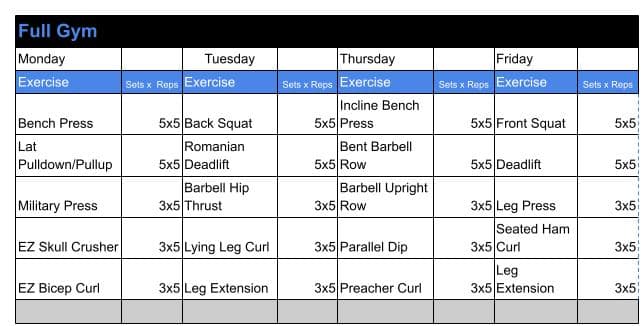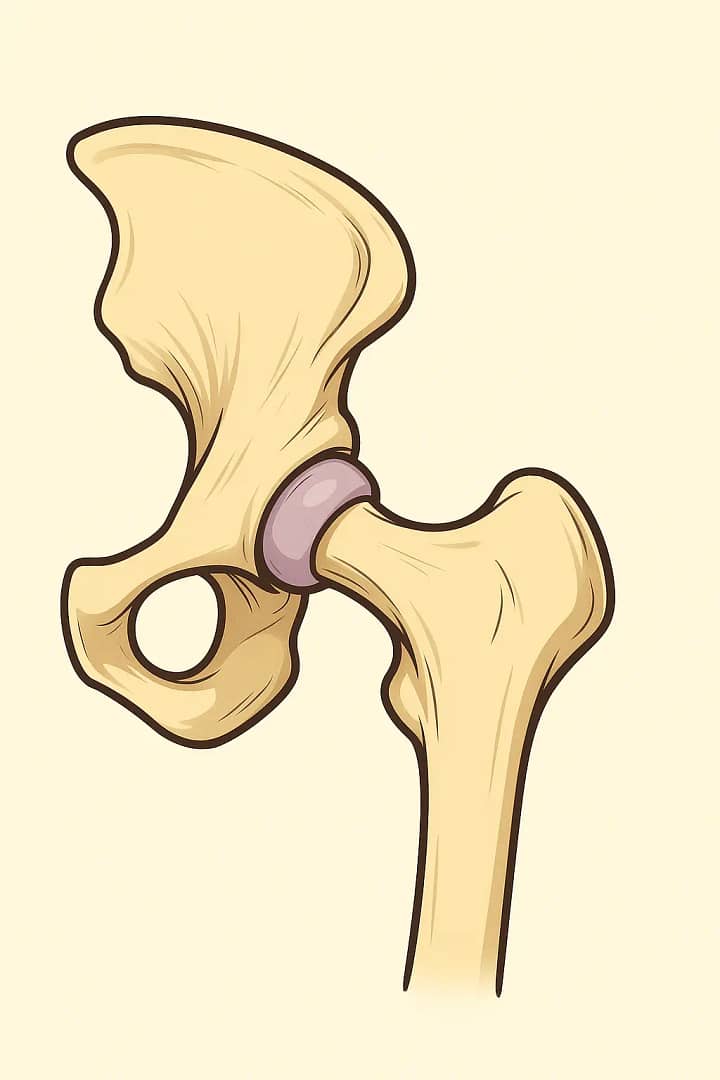5 Reasons to Train with sets of 5
How to implement low rep sets to improve form, power and performance in your training
Strength training is an essential component to fitness that offers many health benefits and can improve athletic performance. One effective approach to strength training is employing sets of 5 in your training. Here are some advantages to training with low repetitions.
Optimal Strength and Power Improvements
Naturally, lowering the number of necessary repetitions will allow you to use heavier loads on the bar. Increasing the mechanical tension on the muscle encourages your body to adapt by recruiting more motor units and muscle fibers, leading to greater improvements in overall strength at a faster rate. Basically, the more weight you can lift, the greater tension put on the muscle fibers.
When training at higher contractile speeds, your muscles will fatigue quicker. But these fast twitch fibers also recover quicker as well. Sets of 5 repetitions lend themselves very well to developing speed and force production when training.
Now that fatigue is no longer an issue when training, you can focus on your form and try to improve your technique with each and every one of your lifts, which will allow your training sessions to be more effective.
Improved Technique
I have attention issues. But even I can stay focused for a set of 5. With fewer repetitions to complete you are able to focus more on perfecting your form and technique. This is particularly beneficial for compound movements like squats, deadlifts and bench presses where a loss of focus could lead to injury. 5 repetitions allows you to stay dialed in on each and every rep. As soon as you get 2 repetitions into a set, you are almost halfway done!
When doing high rep sets, it is only normal that your form would break down. This may not be a problem depending on the exercise, but you may not be getting the most out of your set if you are not focused on controlling the eccentric phase of the lift you are performing.
Why the Eccentric Phase of the Lift is Important
Every lift has phases. Imagine you are performing a bench press. After you unrack the bar, you lower it to your chest. This is the eccentric portion of the movement. After touching your chest you begin to press the bar back to the start position. This is the concentric phase of the lift.
Research is showing that a greater focus on the eccentric portion of the lift yields greater results in muscle hypertrophy which is the enlargement of muscle size.
By focusing on form and controlling the weight, you can accumulate time under tension which is the amount of time your muscles are under constant load. This is also an important aspect of muscle growth because this focus on the eccentric phase coupled with a higher resistance will increase the mechanical tension on the muscle.
You can accumulate time that your muscle is under mechanical by controlling the eccentric phase of each repetition for 3-5 seconds before forcefully contracting the muscle during the concentric phase. If you want to accumulate even more time under tension, apply the same rule of 3-5 seconds to the concentric phase of the lift.
With a focus on a controlled eccentric portion of the lift, and an increase in overall mechanical tension on the muscle, you are well on your way towards increasing muscle hypertrophy. Now it’s time to accrue some volume!
Muscle Hypertrophy
Training with sets of 5 repetitions allows you to not only focus on the eccentric phase of the lift, but also it allows you to get more sets accomplished during your workout. Sets of 5 are quick, so you can easily accumulate 5 sets of 5 or even more.
This is a good thing because research has shown volume to be a key factor in muscular hypertrophy. When trying to build more muscle, your focus should be on the total volume of work.
What is Volume and Why is it Important?
Training volume is typically considered the amount of sets, reps and weight used during a workout. If you bench 100 lbs for 3 sets of 10 your total work is 3000.
But taking advantage of our sets of 5 allows us to accrue more work volume. Let’s use this to our advantage. If we bench press 150 lbs for 5 sets of 5 our total work is 3750. This is just a random example but you can see how 5 sets of five is 5 less total reps (25) than 3 sets of 10 ( 30) and yet the total workload of the 5×5 is still higher.
This means you can accumulate more training volume in a shorter period of time.
The truth is muscle is very dependent on the volume of training. The more you focus on increasing a combination of the sets, total reps and total weight used, the more you will see increases in muscle size.
While sets of 8 – 12 are widely considered optimal for muscle hypertrophy, sets of 5 can also contribute effectively for muscle size. As long as you keep your total volume (total sets) higher, you can take advantage of the extra weight on the bar and increase muscle mass as well as muscular strength.
Time Efficiency/Less Fatigue
For those with busy schedules (not me), training with sets of 5 can be more time efficient and require less strain on your central nervous system, allowing you to recover quicker from sessions.
Training to failure is hard on your central nervous system and may prolong recovery time not only between sets but between training sessions as well. Training to failure has benefits but typically when you train to failure you can’t use nearly as much weight and each set becomes more and more taxing on your central nervous system.
With lower reps you not only will enjoy your workouts more, but because they won’t tax your central nervous system as much, you will be able to recover more effectively. Fewer repetitions means less time spent in the gym and more time recovering allowing you to accumulate more volume of training per week.
Adaptability for all Levels
Whether you’re a beginner or an experienced lifter, sets of 5 can be tailored to your fitness level. Beginners can start with lighter loads, while advanced trainees can challenge themselves with heavier weights.
Sets of 5 are also great when trying to learn new skills.
Some of my favorite training sessions are when I am developing a new skill or practicing a new movement. It could be as simple as a handstand pushup to develop shoulder strength, or a pistol squat for single leg strength or even an L sit hold for core strength and balance. Regardless of what the movement is, keeping the repetitions to 5 and under will allow you to focus on the form of the repetition when learning a new skill.
Grease the Groove!
Training doesn’t have to be conglomerated to one session with an imposed time limit.
The term “grease the groove” refers to a style of training where you do sets in a spaced out manner throughout the day. A set here and a set there, typically when fully recovered.
For example, let’s say you are developing your pullup. You can perform around 1-2 repetitions before tapping out. Instead of focusing on sets and reps, perform a single pullup every 5 minutes or so, or maybe even every hour. If you can hit 2, then do it!
With a mindset of “practicing” a lift such as this, you will find that since you have plenty of time to recover between sets, you can in essence perform more “fresh” sets and over time you will notice that now you are hitting doubles more often, and even hit 3 in a set here or there.
The reason for this is because the body improves the neural drive and motor patterns allowing you to recruit more muscle fibers and get stronger without packing on extra muscle. It finds a way to make the system more efficient.
Strength gains come very quickly with this style of training, because a lot of strength can be developed simply from developing the neural pathway from brain to muscle, rather than actually adding new muscle size.
This “grease the groove” style of training lends itself to trainees of all skill levels. There is no reason not to employ at least this style of training for added strength.
Training Plan
Incorporating sets of 5 into your strength training regimen offers a wide array of benefits including enhanced strength, muscle growth, improved technique, and time efficiency. Whether you’re an athlete aiming for peak performance or someone looking to improve overall fitness, training with sets of 5 can help you achieve your goals effectively.
Below is a training plan for your specific needs. This training protocol can be applied regardless of whether you have a full gym at your disposal or even if you are just training with bodyweight movements.
As with any training program, it’s essential to combine this method with proper nutrition, recovery, and progressive overload to maximize your results.
Training with lower reps has so many advantages. It’s not the only way to train but can be a great way to add variety to your training and possibly make it fun again. It’s not just about burning calories. It is about developing skills and improving strength, allowing for a greater capacity for work so that getting in shape and staying in shape become second nature!
Sample Training Splits (Gym, Dumbbells Only, Body Weight Exercises)



Key Takeaways
References:
- Bourne MN, Duhig SJ, Timmins RG, Williams MD, Opar DA, Al Najjar A, Kerr GK, Shield AJ. Impact of the Nordic hamstring and hip extension exercises on hamstring architecture and morphology: implications for injury prevention. Br J Sports Med. 2017 Mar;51(5):469-477.
- Gluchowski A, Harris N, Dulson D, Cronin J. Chronic Eccentric Exercise and the Older Adult. Sports Med. 2015 Oct;45(10):1413-30.
- Harris-Love MO, Gollie JM, Keogh JWL. Eccentric Exercise: Adaptations and Applications for Health and Performance. J Funct Morphol Kinesiol. 2021 Nov
- Hoppeler H. Moderate Load Eccentric Exercise; A Distinct Novel Training Modality. Front Physiol. 2016 Nov 16;7:483.
- Refalo MC, Helms ER, Robinson ZP, Hamilton DL, Fyfe JJ. Similar muscle hypertrophy following eight weeks of resistance training to momentary muscular failure or with repetitions-in-reserve in resistance-trained individuals. J Sports Sci. 2024 Jan;42(1):85-101.
- Ruple BA, Plotkin DL, Smith MA, Godwin JS, Sexton CL, McIntosh MC, Kontos NJ, Beausejour JP, Pagan JI, Rodriguez JP, Sheldon D, Knowles KS, Libardi CA, Young KC, Stock MS, Roberts MD. The effects of resistance training to near failure on strength, hypertrophy, and motor unit adaptations in previously trained adults. Physiol Rep. 2023 May;11






